Potential Invader
green June bug, green June beetle, figeater beetle
Family: Scarabaeidae Subfamily: Cetoniinae Genus: Cotinis Species: Cotinis mutabilis (Gory and Percheron, 1833)
none available
Total body length 17.0–34.0 mm (0.67–1.34 in). Body shape vaguely pentagonal, somewhat dorsoventrally flattened. Color above velvety green, rarely black or plum; ventralventral:
of or relating to the lower surface; opposite of dorsal
color metallic green, rarely black or brownish; elytral margins or mid-disc often tan. Head with short process at apexapex:
point or edge furthest from the body
of clypeusclypeus:
part of the head anterior to the frons; the most anterior portion in dorsal view
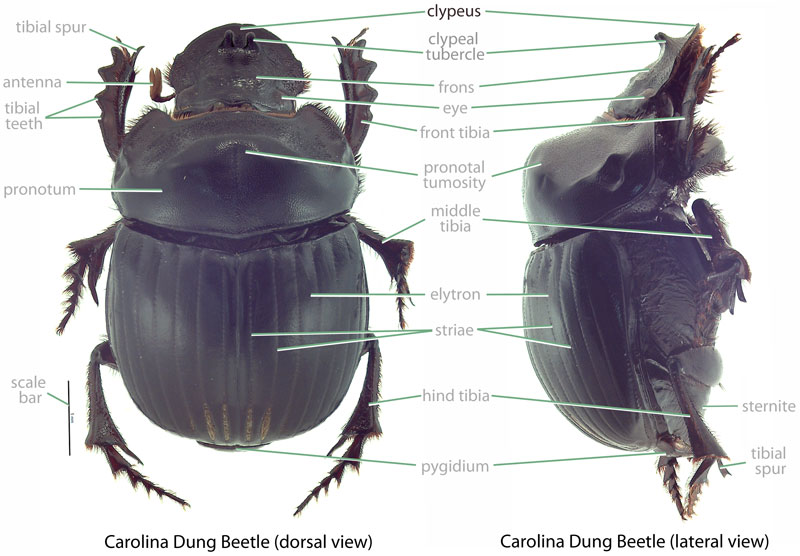 and short, anteriorly produced, horn-like process on fronsfrons:
and short, anteriorly produced, horn-like process on fronsfrons:
part of the head generally positioned between the eyes (posterior to the clypeus and anterior to the vertex) and visible dorsally
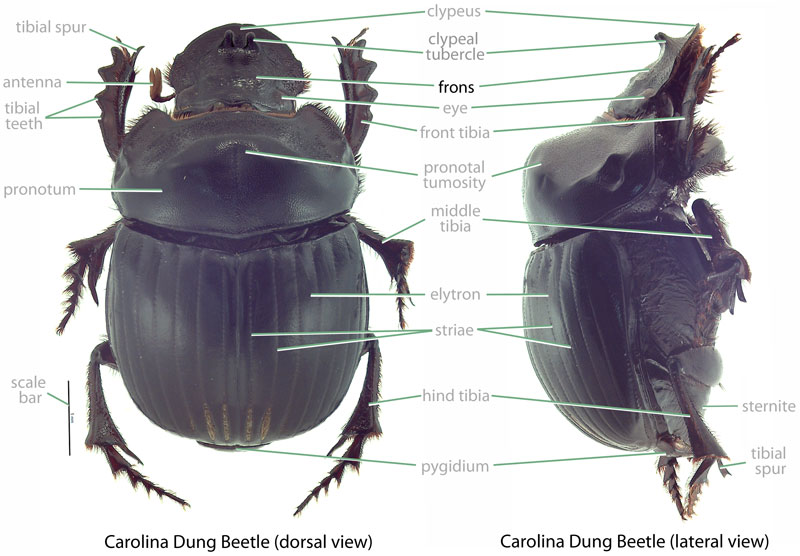 . Scutellumscutellum:
. Scutellumscutellum:
the triangular portion of the thorax between the bases of the elytra
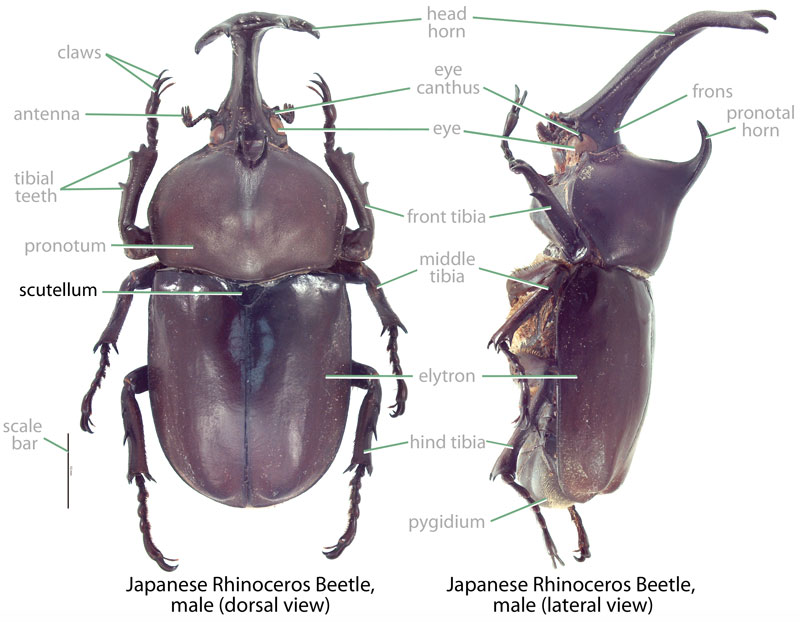 hidden by pronotumpronotum:
hidden by pronotumpronotum:
the dorsal surface of the thorax
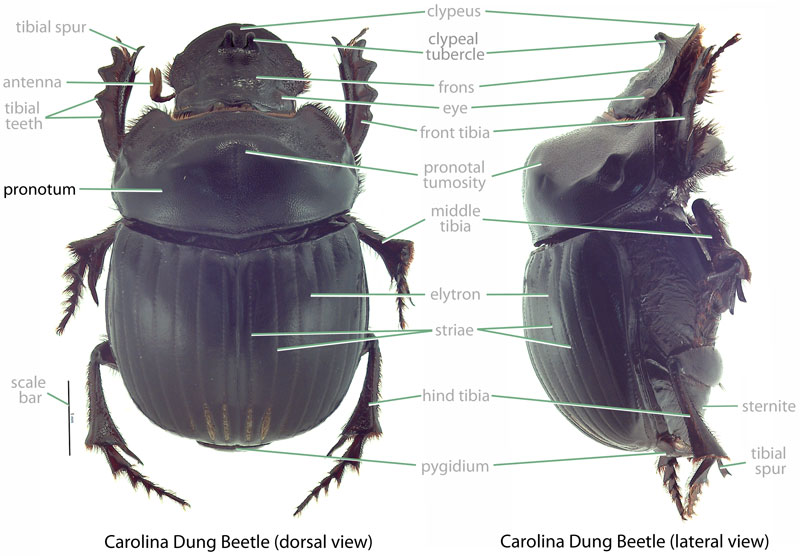 . Sternumsternum:
. Sternumsternum:
ventral surface of the thorax
with strongly produced metasternal keelkeel:
longitudinal, ridge-like ventral process
.
(Ritcher, 1966Ritcher, 1966:
Ritcher P. 1966. White grubs and their allies: a study of North American scarabaeoid larvae. Oregon State University Monographs, Studies in Entomology 4: 1-219.): Live larvaelarvae:
the immature form of an insect; in scarabs, also called grub or white grub; preceded by the egg stage, followed by the pupal stage
 crawl on their backs, legs up, and feel distinctly "squishy". Grub C-shaped, not hump-backed, cylindrical, whitish. Maxillamaxilla:
crawl on their backs, legs up, and feel distinctly "squishy". Grub C-shaped, not hump-backed, cylindrical, whitish. Maxillamaxilla:
set of paired mouthparts located posterior to the mandibles
with galeagalea:
outer branch or lobe of the maxilla
 and lacinialacinia:
and lacinialacinia:
inner portion of the maxilla fused or nearly so. Labrumlabrum:
fused or nearly so. Labrumlabrum:
upper lip that covers the mandibles and is located ventrally relative to the clypeus
 symmetrical, trilobed. Lacinialacinia:
symmetrical, trilobed. Lacinialacinia:
inner portion of the maxilla with fewer than 3 well-developed, terminal unciunci:
with fewer than 3 well-developed, terminal unciunci:
in scarab larvae, a hooked process on the distal margin of the maxilla
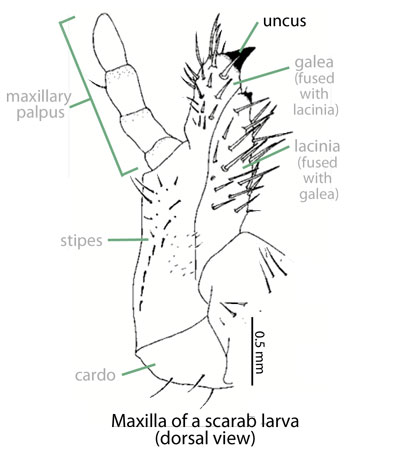 . Last antennal segment with sensory spots. Claws cylindrical; bearing 7 or more setaesetae:
. Last antennal segment with sensory spots. Claws cylindrical; bearing 7 or more setaesetae:
small, hair-like structure
. Abdominal segments 9 and 10 fused. Anal opening transversetransverse:
extending horizontally across a surface
, straight or slightly curved. Rasterraster:
in scarab larvae, a complex of setose, spiny, and bare areas on the ventral surface of the last abdominal segment with 2 or more irregular rows of pali; inner row of each palidiumpalidium:
with 2 or more irregular rows of pali; inner row of each palidiumpalidium:
paired group(s) of recumbent (reclining) spines, usually occurring in rows; part of the raster
having 7–10 palipali:
in scarab larvae, a straight, pointed spine, particularly as relates to the raster
each much larger than those palipali:
in scarab larvae, a straight, pointed spine, particularly as relates to the raster
in the outer row.
Southwestern U.S. to northern South America. This species occurs from the southwestern U.S. (California, Nevada, Utah, Arizona, New Mexico, and Texas) south through Mexico and Central America into northern South America (Goodrich, 1966Goodrich, 1966:
Goodrich M. 1966. A revision of the genus Cotinis (Coleoptera: Scarabaeidae). Annals of the Entomological Society of America 59:550–568.).
Adults have been reported on a number of plants, most of which are thin-skinned fruits: apple (Malus spp.), apricot (Prunus armeniaca), blackberry (Rubus spp.), grape (Vitis spp.), fig (Ficus carica), nectarine (Prunus persica), peach (Prunus persica), pear (Pyrus spp.), pineapple (Ananas comosus), plum (Prunus domestica), raspberry (Rubus spp.), and tomato (Solanum lycopersicum) (Davis, 2014Davis, 2014:
Davis R. 2014. Who's in your compost?. Utah Pest News, Utah Plant Pest Diagnostic Laboratory and USU Extension 8: 6. full text (accessed 2015)). There are also reports of larvaelarvae:
the immature form of an insect; in scarabs, also called grub or white grub; preceded by the egg stage, followed by the pupal stage
 damaging pineapple roots (Joy et al., 2013Joy et al., 2013:
damaging pineapple roots (Joy et al., 2013Joy et al., 2013:
Joy P, Anjana R, Soumya K. 2013. Pests of pineapple and their management. Pineapple Research Station, Kerala Agricultural University, India. full text (accessed 2015)).
Adults of this species are diurnaldiurnal:
active during daylight hours
, flying actively and noisily while searching for feeding or oviposition sites (Chapell, 1984Chapell, 1984:
Chappell M. 1984. Thermoregulation and energetics of the green fig beetle ( Cotinus [ sic ] texana ) during flight and foraging behavior. Physiological Zoology 57: 581–589. full text (accessed 2015)). In Utah, adults are active in July and August (Davis, 2014Davis, 2014:
Davis R. 2014. Who's in your compost?. Utah Pest News, Utah Plant Pest Diagnostic Laboratory and USU Extension 8: 6. full text (accessed 2015)), while in California adults are seen May through early October (Chapell, 1984Chapell, 1984:
Chappell M. 1984. Thermoregulation and energetics of the green fig beetle ( Cotinus [ sic ] texana ) during flight and foraging behavior. Physiological Zoology 57: 581–589. full text (accessed 2015)). Eggs are laid in compost, manure, or organic rich soils, where larvaelarvae:
the immature form of an insect; in scarabs, also called grub or white grub; preceded by the egg stage, followed by the pupal stage
 feed on organic debris and detritusdetritus:
feed on organic debris and detritusdetritus:
organic debris; particularly plant debris
(Davis, 2014Davis, 2014:
Davis R. 2014. Who's in your compost?. Utah Pest News, Utah Plant Pest Diagnostic Laboratory and USU Extension 8: 6. full text (accessed 2015)).
Minor. Unlike the very similar looking Cotinis nitida, C. mutabilis is not a significant pest (Davis, 2014Davis, 2014:
Davis R. 2014. Who's in your compost?. Utah Pest News, Utah Plant Pest Diagnostic Laboratory and USU Extension 8: 6. full text (accessed 2015)). Adults do not damage developing fruit, but they may actively seek out ripe fruit (Chapell, 1984Chapell, 1984:
Chappell M. 1984. Thermoregulation and energetics of the green fig beetle ( Cotinus [ sic ] texana ) during flight and foraging behavior. Physiological Zoology 57: 581–589. full text (accessed 2015)) and can cause minor damage, particularly to thin-skinned fruits (Davis, 2014Davis, 2014:
Davis R. 2014. Who's in your compost?. Utah Pest News, Utah Plant Pest Diagnostic Laboratory and USU Extension 8: 6. full text (accessed 2015)). There are few reports of larvaelarvae:
the immature form of an insect; in scarabs, also called grub or white grub; preceded by the egg stage, followed by the pupal stage
 damaging roots (Camino-Lavín et al., 1996), although it is not clear that this is a common occurrence.
damaging roots (Camino-Lavín et al., 1996), although it is not clear that this is a common occurrence.
Recorded, not established. In Hawaii, this species has been intercepted in quarantine at Hilo on Big Island. The specimen was collected in 2014 in an automobile that originated from San Diego, California. A 1964 record for Cotinis, also intercepted arriving from California, probably refers to this species (Look, 1974Look, 1974:
Look W. 1974. Efficacy of Hawaii's plant quarantine program. Proceedings of the Hawaiian Entomological Society 21: 413-418. full text (accessed 2015)).
Not established or recorded. There are no records of this species from Guam.
This diurnaldiurnal:
active during daylight hours
species is both widespread and a powerful flier (Chapell, 1984Chapell, 1984:
Chappell M. 1984. Thermoregulation and energetics of the green fig beetle ( Cotinus [ sic ] texana ) during flight and foraging behavior. Physiological Zoology 57: 581–589. full text (accessed 2015)). It is possible that the frugivorous adults could be transported in commercial shipments of fruits, as may have occurred with the 2014 specimen.
Though distinctive amongst recorded Hawaiian and Guamanian species, it is possible this beetle could be confused with Protaetia orientalis (Asian flower beetle) or Protaetia pryeri (Midway emerald beetle). A number of characters are useful in separating Cotinis and Protaetia, including: scutellumscutellum:
the triangular portion of the thorax between the bases of the elytra
 (Cotinis mutabilis with scutellumscutellum:
(Cotinis mutabilis with scutellumscutellum:
the triangular portion of the thorax between the bases of the elytra
 hidden under pronotumpronotum:
hidden under pronotumpronotum:
the dorsal surface of the thorax
 versus scutellumscutellum:
versus scutellumscutellum:
the triangular portion of the thorax between the bases of the elytra
 clearly visible in Protaetia spp.), color (Cotinis mutabilis usually velvety green versus dark brown or black with white maculationsmaculations:
clearly visible in Protaetia spp.), color (Cotinis mutabilis usually velvety green versus dark brown or black with white maculationsmaculations:
markings; particularly in reference to blurred or blotchy markings
in Protaetia orientalis, shining bright green in Protaetia pryeri), head armature (Cotinis mutabilis with short, horn-like process on the fronsfrons:
part of the head generally positioned between the eyes (posterior to the clypeus and anterior to the vertex) and visible dorsally
 and produced clypealclypeal:
and produced clypealclypeal:
of, or referring to, the clypeus
apexapex:
point or edge furthest from the body
versus head armature absent in Protaetia spp.), and metasternal keelkeel:
longitudinal, ridge-like ventral process
(Cotinis mutabilis with metasternal keelkeel:
longitudinal, ridge-like ventral process
strongly produced, versus metasternal keelkeel:
longitudinal, ridge-like ventral process
reduced in Protaetia spp.).
Cotinis abdominalis Casey, Cotinis arizonica Casey, Cotinis atrata (Gory and Percheron), Cotinis capito Casey, Cotinis malinus Janson, Cotinis mexicana (Gory and Percheron), Cotinis nigrorubra (Gory and Percheron), Cotinis obliqua Casey, Cotinis palliata (Gory and Percheron), Cotinis sobrina (Gory and Percheron), Cotinis texana Casey, Gymnetis mutabilis Gory and Percheron
In Hawaii, this species represents a new invasiveinvasive:
a species that has recently arrived to a new location, usually via human activity, causing notable economic and/or ecological damage
species. Prevent the spread of this species by reporting your observation at our iNaturalist project.